
If confirmation were needed that drilling is indeed not thrilling for the South Australian electorate, today's Sunday Mail has provided it in spades.
The Arkaroola campaign is featured on the front page, with a stunning photograph of The Armchair (one of the region's wild post-volcanic peaks) on the front page of the weekly 'Insight' lift-out, in an editorial ('No place for a mine') on page 34, in a magnificent double-page photospread beginning on Page 38, and, crucially, in another double-page poll-based spread on pages 8 and 9 - Voters give Labor a right whack (which could just as well have been called 'Voters give Labor Right a whacking!', but I digress!)
Its worth quoting this piece, which is based on the Sunday Mail's own survey conducted earlier this week -
Labor's woes may be compounded by its recent renewal of Marathon Resources' exploration licence in Arkaroola - the poll found 72 per cent of people felt mining should not be allowed in the region. The "no" vote was a whopping 79 per cent among intending Labor voters - even higher than among Greens' supporters.
Arkaroola director Marg Sprigg said she was distressed by the decision to allow Marathon to continue exploring.
"We don't believe a company like Marathon should be allowed back in here," she said. "They want to do a lot more drilling in a much wider area than just around Mt Gee; they will be drilling into the very heart of Arkaroola."
Marathon is searching for uranium in a 90sq km tenement in the sanctuary. Its drilling rights were suspended in February 2008 after it was found to have illegally dumped exploration drilling waste.
The company says the area has the nation's fifth largest undeveloped uranium deposit with 31,300 tonnes identified.
Marathon chairman Peter Williams said more discoveries were likely and the new phase of exploration would extend several kilometres east of Mt Gee to assess the size of the deposit with drill holes as deep as 500m.
Relations between Arkaroola and Marathon have broken down, with Marathon now planning to fly in workers by helicopter each day from a neighboring property rather than pay to stay in Arkaroola village.
Mineral Resources Development Minister Tom Koutsantonis said the Government - which has heavily promoted its pro-mining credentials - was legally obliged to renew Marathon's licence but was considering a range of conservation options "which may include exclusion, or limiting of mining".
"This does not confer any right to mine the area," he noted. [Emphasis mine]
Here's the figures for that poll:
QUESTION 5: Should mining be allowed in the Mt Gee area of the Arkaroola Sanctuary?
YES - 22% (all), 19% (Labor voters), 25% (Liberal voters), 19% (Greens voters), 8% (Family First voters)
NO - 72% (all), 79% (Labor voters), 68% (Liberal voters), 71% (Greens voters), 89% (Family First voters)
DON'T KNOW - 6% (all), 2% (Labor voters), 7% (Liberal voters), 10% (Greens voters), 3% (Family First voters) [emphasis mine]
Note to the Labor Party - when an institution as conservative as the Sunday Mail carries not only this poll, but this editorial and a front page emblazoned with the 'NO MINE IN ARKAROOLA' sticker and the words 'Ark Up - the fight to save a wilderness' it's clear that in granting a return to active exploration in the sanctuary you have become so divorced from public sentiment that you really are at risk of being forever lost in the wilderness yourselves!
Reshuffling the deck chairs in cabinet didn't work. People want to see results, not the same rhetoric spilling from new faces. The message could hardly be clearer; the old men of the Labor Party have saddled the new blood with an albatross - or perhaps a turkey? - around their necks in the ongoing farce in Arkaroola. Either way, Labor needs to ditch the bird - or pay the price!
I'll finish with one more quotation from the Sunday Mail. I suggest that, if the situation is not swiftly rectified - it will prove prophetic;
The Mt Gee area of the Arkaroola Wilderness Sanctuary, in the northern Flinders Ranges, is one of Australia's most awe-inspiring landscapes - and also the setting for what looms as one of the biggest environmental battles since the Franklin River protests in Tasmania in the 1980s.



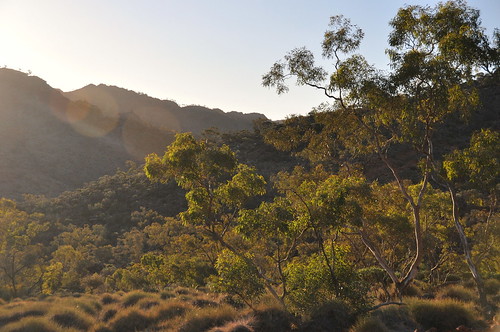
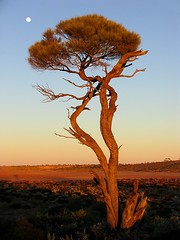
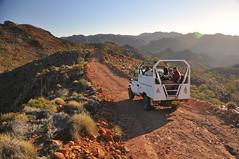
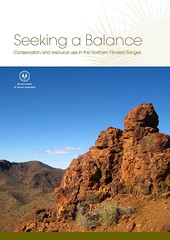
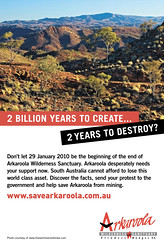
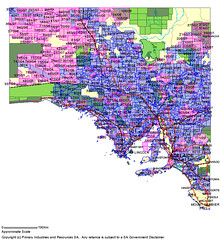
![link to the u[n]sa homepage](http://users.chariot.net.au/~greenh/blog/unknownsa_ublog-text.gif)


![link to the u[n]sa features page](http://users.chariot.net.au/~greenh/blog/features_ublog-text.gif)
![link to the u[n]sa kangaroo island feature image pages](http://farm2.static.flickr.com/1306/1187313059_93fdefd86b_o.jpg)
![link to the u[n]sa katarapko creek / murray river np feature image pages](http://farm2.static.flickr.com/1435/1181073355_b5c45f799d_o.jpg)


!['constellation' - wild country [national] set on flickr](http://farm1.static.flickr.com/155/415123844_3e6da621e5_s.jpg)

!['the bay serene' - the wild west [coast] set on flickr](http://farm1.static.flickr.com/121/312226516_606ac35455_s.jpg)








![u[n]sa journal -thanks for your time! u[n]sa journal - thanks for your time!](http://users.chariot.net.au/~greenh/blog/journal_ublog-text.gif)